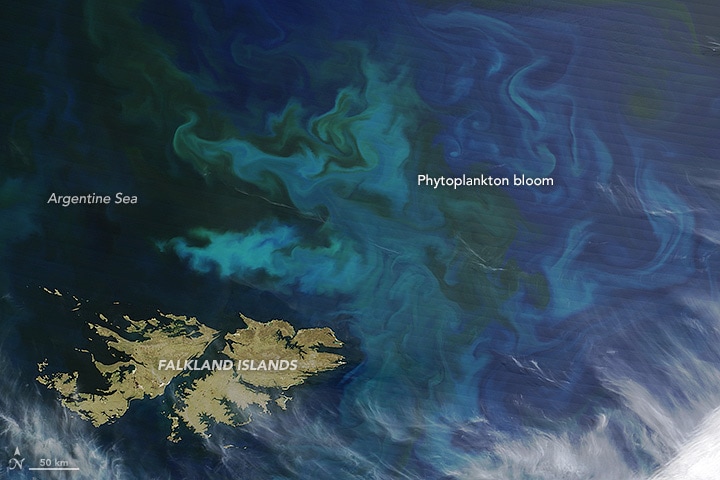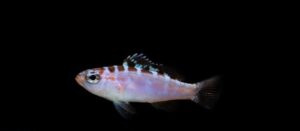The first link in a food chain is always a primary producer, like phytoplankton (i.e. algae, plants, various types of bacteria). This is because all other living things—consumers—are incapable of synthesizing organic substances from inorganic ones. Primary producers rely on inorganic sources of energy (sometimes chemical, but usually from light). Using this energy, they take substances such as ammonium and phosphate and convert it into biomass—biomass that may be consumed by herbivores and subsequently passed down the chain. Consumers generate metabolic wastes such as carbon dioxide and ammonium, which are readily taken up and recycled by the growing producers.
Phytoplankton are basically tiny (generally unicellular), plant-like organisms. Most of the phytoplankton are from a large group of distantly related primary producers referred to as the algae. Though they do not share similar lineages, they are strikingly similar in form and habit; all are miniscule, photosynthetic organisms that live suspended in the water column. It is believed that they carry out most the planet’s primary production. Indeed, life on Earth wouldn’t be even remotely the same without them. And almost as importantly? They can improve the health of a marine aquarium system.
The Green Machine
The world’s oceans are crisscrossed by steady surface water currents. When they collide into landforms or into each other, some are driven to the depths. This action pushes deep waters up to the surface in a process called upwelling. These waters from the deep are laden with nutrients. Why? Because when anything dies in the water column, it sinks to the sea bottom. There, nutrients accumulate, since mixing between different ocean water layers is minimal. Minimal, except, in areas of strong upwelling! This critical ecological process is known as the biological pump.
[Phyto]
Other than dissolved nutrients, there is a lot of something else in the shallows of an upwelling zone: light! This means that photosynthetic plankton may thrive there. These areas sometimes produce vast pastures of phytoplankton that may be observed from space. Massive blooms produce a heady amount of microalgae that spread out into the rest of The Ocean.
That last part is critical—this is a major source of the phytoplankton on coral reefs which are notoriously nutrient-poor environments. Plankton simply washes in from the open ocean via the tides. Though phytoplankton species claim only a modest portion of primary production on the reef itself, they are nevertheless important in that they serve as a major source of vital nutrients such as omega fatty acids.
Using Phytoplankton in ReefAquaria
Various products are available for home aquarists that wish to use phytoplankton. These might supplement the diets of disparate invertebrates including certain corals, clams, tube worms, sponges, and other such fine-particle filter-feeders. They also promote large populations of pods, which depend upon phytoplankton during certain (especially larval) life stages.
These may be live or preserved products. The idea with all of them is to add just a little at a time, but frequently, rather than adding a whole lot on rare occasions. Some aquarists even feed continuously by way of dosing equipment. It’s just fine, though, to pour in a small amount once each evening. Think of it as replenishing with the tidal cycle. You only need to use enough to impart a barely discernible greenish or yellowish tint to the water (this will go away very quickly as the phytoplankton is consumed).
What Makes a Good Phytoplankton-based Aquarium Feed?
There are a handful of “phyto” aquarium foods in the marketplace. They can vary quite significantly from one another in many respects. The best phyto product has the following attributes:
- It is a live (rather than dead and preserved) product.
- It is nutritionally balanced.
- It contains a wide range of cell sizes.
- It is easy to use.
Live products are vastly superior for a number of reasons. First, a product made up of intact, living cells is a lot cleaner as a feed than those that are made of dead stuff. So, it’s much harder to pollute your tank from overdosing when using live phyto. In fact, live and growing phyto actually removes waste products from the aquarium water! Also, it stays up in the water column where filter-feeders can get it, unlike some dead or artificial formulas that quickly settle out over the tank bottom.
Mixed-species phytoplankton products are preferable. Why? Because no single species of phyto is perfect. The right blend of species, however, can result in an ideal nutritional profile. It also provides a wider range of cell sizes; this is great because it makes sure that all different types of filter-feeders get their share.
Is phyto easy to use? It can be, and it should be. The best products come in a resealable container that is suited for multiple use. Some even come in a bottle with a dosing neck for easy measurement. Your dosing routine can be really simple by setting up a subscription for regular, automatic shipments of live phyto by mail. As many successful reef aquarium hobbyists will attest, adding phytoplankton is well worth the small investment in effort and time!
[Phyto]






Robert Espinosa says
The phytoplankton I have a crush on which I learned about from AlgaeBarn is OceanMagik. Thank you, Greg, for turning me onto this product that has made my tank diamond clear and kept my corals vibrant and absolutely gorgeous. When setting up my RedSea 170 I struggled with excess slime and stringy brown algae. OceanMagik has helped make my tank a spectacular showpiece. Thanks Greg!! Get your OceanMagik and witness the transformation for yourself!
cliff says
sweet
Karen says
I love my culture
knarf083 says
Nice
Jeremy says
phydo is the bomb
Edwin Boston Jr. says
Not a big fan. I tend to always over feed…somehow.
Jeremy says
phydo rocks
Gary says
I love phyto
Richard says
So if my bottle of ocean magik is outdated by a few weeks but does not smell like sulfur or anything foul, can my tank still benefit?
Joanna Idiaquez says
I’ve used phyto in the past. I noticed results quickly. I’ve regretted the day I stopped using it. Need to get back in it since I’ve got more corals now.
Luis Ruiz says
Get back in
Joanna Idiaquez says
I’ve used phyto in he past when I had a few corals. Now that I have more, I need to start using it more. Noticed a difference with the few corals I had. Phyto is awosme.
Brandon says
Phytoplankton is so important to our reef tank’s and I don’t think most people realize that. I try to spread the message. Great job Algaebarn!
Andrew says
Worked really well corals loved it and made my pod population thrive
Angel Alcay says
Feeding phyto helps keep my algae in check
Robert Blevins says
Phyto is best applied prior to weekly water changes yes?
mcc says
I think it is better to dose you tank with phytoplankton after water changes, so that copepods and invertibrats can continue to feast on it. If like bacteria, you should start with small doses of phytoplankton until the population of pods increases during the first few weeks then increase dosing to the recommended phytoplankton doses for your tank size.
Julia Burr says
Do you need in a non reef tank?
Joseph Post says
I need to start purchasing phyto!
seitzjh says
interesting
Kenta Asazu says
SUperb!!
Jose Davila says
The phytoplankton is good and helped to keep my corals healthy
Luis Ruiz says
Got it ?
ponygirl112 says
Wish I could grow my own phytoplankton
brennanlottes says
I want to try and grow phyto can I use oceanmagik for this?
Rhonda L Swetnam says
Very useful information! Thank you!
Manuel A Ferro says
love the info thanks!
Charles Wheeler says
Thanks for the info, I’ve been doing quite a bit of research on phyto recently.
Rich Knox says
Awesome info, you guys rock!!
Kelly Huntamer says
This is pretty interesting and makes plenty of sense. I think I will try live once I’m out of my current supply. Thanks Algae barn!
Chad Sosby says
Healthiest pods money can buy right here at Algae Barn!
Tanya BAZALDUA says
Good info
Jon Andrianos says
Ocean magic is awesome
Leslie Pustilnik says
Phyto is a great addition to the health of your reef – thanks for helping to spread the word, AND the phyto!
Richard Quickley says
Good read
Rudy Brambier says
Good info.
Christopher Burns says
good read
Chris G. says
great info
Victoria Brewer says
My pods love phyto
jordan16leblanc says
Looking forward to getting my phyto in
jamesdylanmccraw says
Love that info
Menerd The Menace says
nice
Ricky J Gronwall says
I definitely need to order some more soon. It’s great in my tank.
Robert says
Is it hard to cultivate phyto i know for you chemists it’s not but what about for a regular me
Jack Goldstein says
My tank is doing great thanks to phyto.
Wesley Paulson says
Great stuff!
Ken Ishiki says
I dose daily for my copepod population
Douglas Campbell says
I need to feed phyto more often always forget to get some
Adrien says
I will forever use them in all my tanks
Debra Scoggins says
Is it beneficial to start dosing phyto after the tank has cycled, but before adding corals to get a good population going in the tank?
Sean Tadjeran says
Hi Debra,
Yes, we recommend adding phytoplankton and copepods to your tank after the cycle so that you can build up a huge population!
Savoury Kem says
Interesting
Meb_boisvert@hotmail.com says
Great info, thanks!!
Diana Aliprandi says
Yet another item I need to get from you. Love the bottles that I had the past.
Compy Ginorio says
I need phytoplankton for my upgrade.
Carol Mauch says
Gotta get an order in this week!
Jonathon Berry says
Great info
Dwayne Newell says
This stuff is like magic, turns the tank in to a heather Environment.
Krish says
Awesome stuff
Jose Ponciano says
Thanks for the reading material while I wait at Sephora
Wife shopping for make up .. but you phyto is awesome love it..
Robert Vice says
I’ve been dosing daily for a couple weeks now and the pod population have I creased I switched from cheato and Kent marine concentration to sea lettuce and ocean magic and I thinks it’s working my nitrates have gone down significantly
Jorge says
Good basic info on plankton!
Nelly Acevedo says
Thanks for the info
Alyssa says
Was originally going to buy pods from my local fish store, but they said nothing about the pytho. I started doing some searches and when I found this site I was happy about how much information they provided, and also the bundle packs that included what benefits eachother and your tank. Love this company
Andrew B says
plankton ftw!
chris head says
plankton, the green power machinew!
Kris Kasarda says
Great post!
cgault99 says
Good read.
Andrew says
Informative
Nick says
This was a nice read glad I found it on your page!
Carrie Harvey says
So much to think about
Kenneth Showman says
Thank you Algae Barn.
Pat says
My claim loves this stuff like crazy
Luis Ruiz says
Awesome products
David Williams says
You have the phyto so the next logical step is to work on rotifiers. Breeders and coral owners are both consumers and it would fit in well with your niche portfolio.